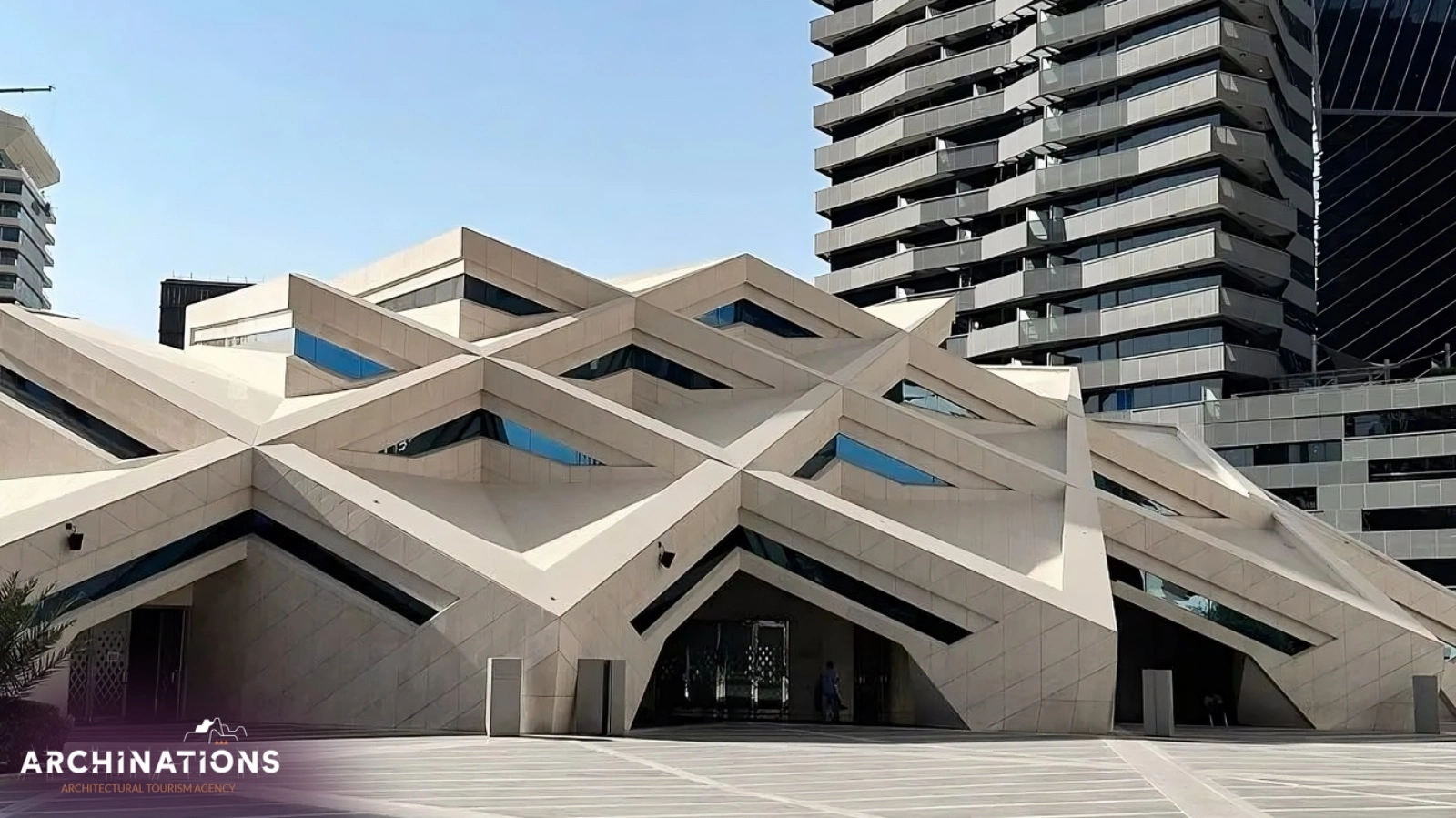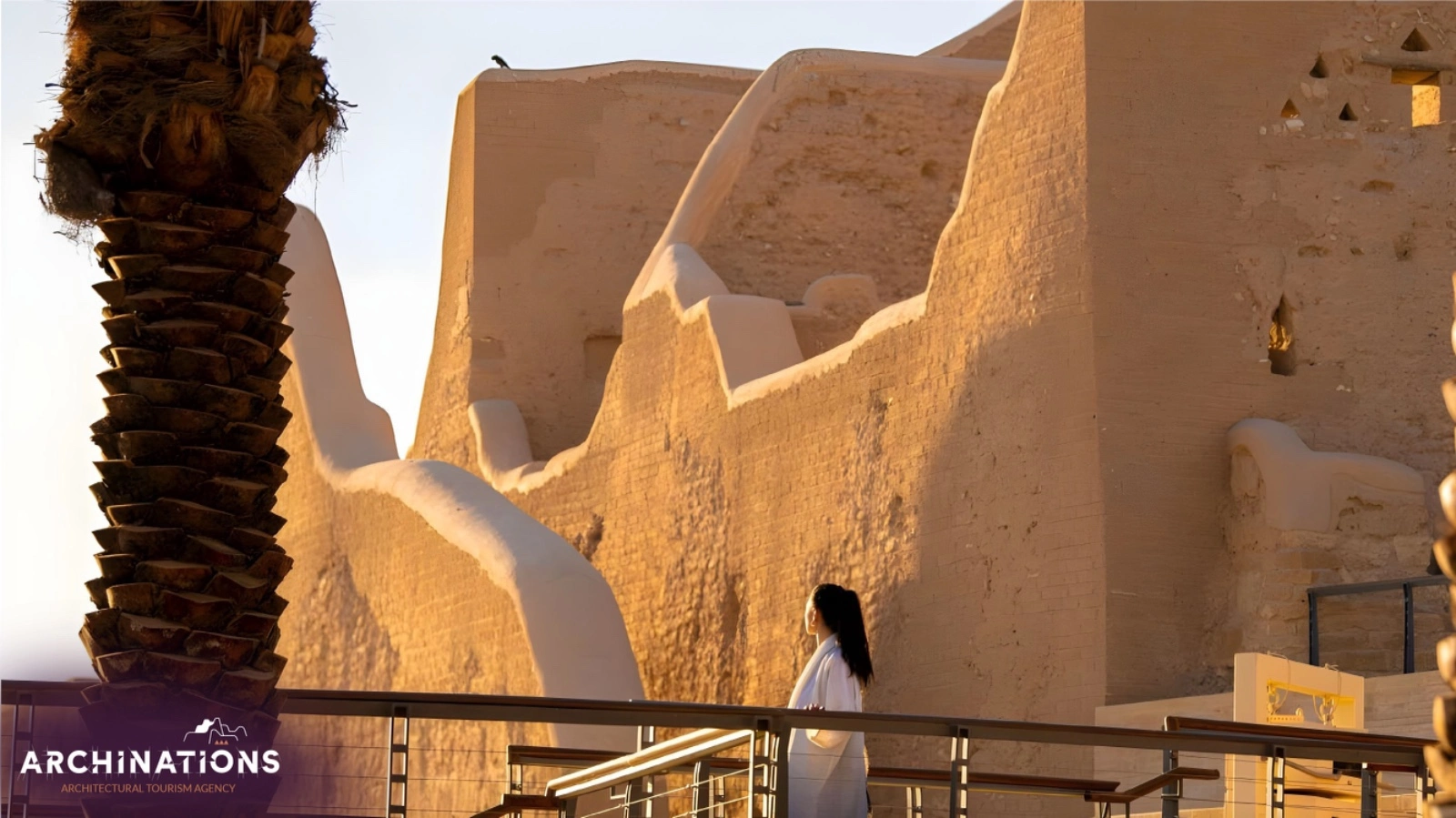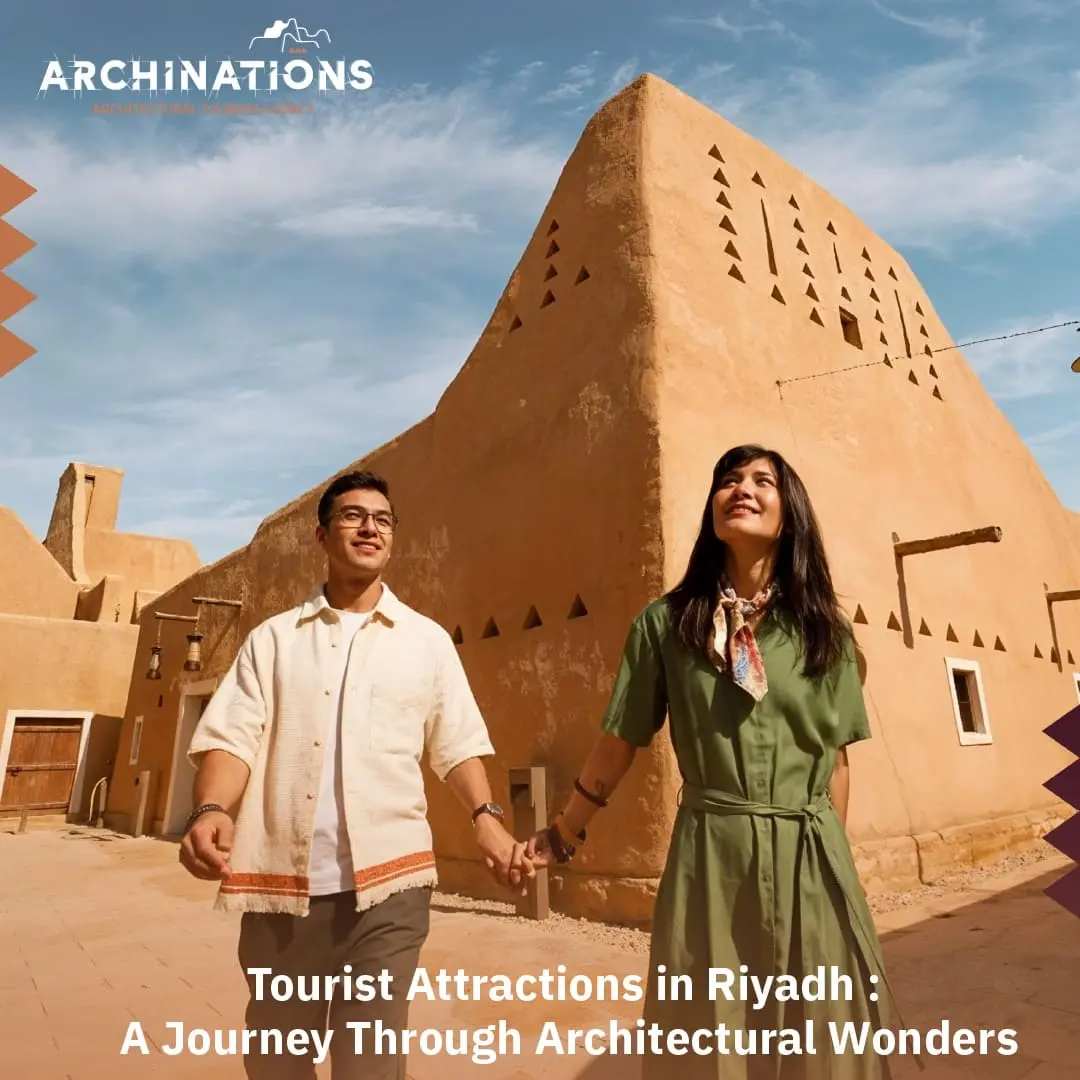When Architecture Speaks the Language of Riyadh!
Riyadh is not just the political and economic capital of Saudi Arabia, but a city that speaks fluently through its walls, columns, stations, and towers. It is a massive architectural canvas that combines the glorious past with a vibrant future, housing many tourist attractions in Riyadh that narrate its history and express its ambitions. In this city, an experienced eye can read the passage of time through the details of buildings and design elements. If the architecture of cities is a mirror of their identity, Riyadh is one of the cities that most vividly reflects that identity through its multi-faceted architecture. From ancient markets to smart districts, from forts to skyscrapers, tourist attractions in Riyadh reveal an exciting architectural story told only by those who cherish details, like Archinations.

What to Do in Riyadh?
If you’re wondering about the experiences waiting for you in Riyadh, the list is long:
- Explore historic sites like Masmak Fort and Murabba Palace.
- Enjoy contemporary art at Jax District.
- Attend exhibitions at Diriyah Season and immerse yourself in cultural events.
- Visit the National Museum and dive into the history of the Arabian Peninsula.
- Head to the King Abdullah Financial District and explore the future of architecture.
- Ride the modern Riyadh Metro and witness the blend of technology and design.
- Move between traditional markets and art galleries.
- Indulge in fine dining at skyscraper restaurants.
Riyadh is not just a place to live; it’s an experience best explored through the lens of its architecture. Let us take you on a visual journey to discover the top tourist attractions in Riyadh through a unique architectural perspective.

Riyadh Metro: A Unified Design Language with a Global Signature
The Riyadh Metro is an urban artery connecting the city’s edges within an advanced network that reflects a modern urban vision. Its stations and service centers, meticulously designed, highlight the smart balance between operational efficiency and local architectural identity. Curved metal structures flow smoothly, mimicking the horizon lines, while the interior finishes reflect the desert sands and tranquility, making the metro a living architectural component that blends seamlessly with Riyadh’s urban fabric.
The Riyadh Metro is not just a means of transportation; it is a complete design masterpiece. From the tunnel to the surface, attention to aesthetic detail is evident, with a focus on visual and functional comfort. The use of earth tones, glass surfaces, and directed lighting details gives this daily experience an unmatched architectural character. With six lines and more than 80 stations, the metro stations stand as a unique architectural achievement. The stations are designed using a cohesive yet flexible architectural language, combining natural ventilation, sustainable lighting, and repetitive modules with a unified identity. Materials such as aluminum and local stone emphasize the harmony between modernity and the desert environment.
-
Qasr Al Hukm Metro Station: A New Urban Icon
Located in the heart of Riyadh’s historic center, Qasr Al Hukm Metro Station is one of the most distinctive stations in the Riyadh Metro. Its design merges contemporary style with visual cues from Najdi architecture. Vertical window rhythms, arches inspired by old castles, and the vast hall resembling traditional courtyards all emphasize how architecture can honor the past while moving toward the future.
-
STC Metro Station: A Landmark Full of Modernity
In the heart of bustling Riyadh, STC Metro Station stands as one of the prominent stations in the Riyadh Metro project. It’s not just a modern transportation facility but a true architectural masterpiece that reflects the Kingdom’s future vision. With sleek design elements inspired by dynamic lines and advanced technology, this station seamlessly blends function and beauty, offering a comfortable and smooth transit experience that connects you to Riyadh’s most important landmarks.
Whether you’re a visitor looking for easy access to the top tourist attractions in Riyadh or a resident exploring the city in a new way, STC Metro Station represents the ideal starting point. It is more than just a transit station، it is an urban experience that reflects Riyadh’s modern spirit and its intelligent approach to future cities.
-
KAFD Metro Station – An Architectural Icon in the Heart of Modern Riyadh
At the heart of the Saudi capital, one of the key tourist attractions in Riyadh is KAFD Metro Station. Designed by the renowned architect Zaha Hadid, this station blends innovative engineering with the futuristic vision of urban mobility. Connecting the metro’s blue, yellow, and purple lines and the King Abdullah Financial District Metro, it serves as a vital point in Riyadh’s wider transport network.
The station features a flowing exterior inspired by traditional mashrabiya patterns and sand dune formations, giving it a unique character that combines both authenticity and modernity. Spanning approximately 8,150 square meters, the station houses six train tracks across four levels, complete with pedestrian walkways, public squares, and waiting areas, enhancing the transit experience while reducing congestion.
Discover the architectural splendor of Riyadh Metro stations through a guided tour that takes you on a visual journey across its most iconic landmarks.

Historic Sadous Village: Mud Architecture and Najdi Identity
Historic Sadous Village is one of the most notable tourist attractions in Riyadh, offering a living model of traditional Najdi architecture with its thick mud walls, small windows, and palm-frond roofs. The village serves as an open-air architectural museum, showcasing how houses were built to withstand the desert heat while preserving privacy. Preserving this village reflects the importance of safeguarding local architecture as part of the region’s cultural memory. Located about 70 kilometers northwest of Riyadh, Sadous is one of the oldest human settlements in the Najd region, with roots dating back to pre-Islamic times. It was once home to tribes such as Tasm, Jadis, and Banu Hanifa.
Sadous is distinguished by its traditional Najdi architecture, featuring mud buildings adorned with unique decorative carvings. Among its historic neighborhoods are Al-Bilad, which includes a palace with five towers; Al-Ra’s, built in 1305 AH; and Jeddah, which saw settlement beginning in 1343 AH. One of its most prominent archaeological landmarks is a stele inscribed with ancient carvings and writings, serving as a testament to its deep-rooted history.
The village has undergone restoration projects aimed at preserving its architectural heritage and transforming it into a tourist destination with a traditional hotel, heritage museum, and local marketplace.
Would you like to visit Historic Sadous Village and explore its architectural treasures? Book your experience through Archinations.
The National Museum of Saudi Arabia in Riyadh: Geography Speaks Through Stone
The National Museum of Saudi Arabia in Riyadh is a structure that blends geography with cultural identity. Its design, inspired by sand dunes and composed of curved organic shapes, captures the spirit of the desert while utilizing light and shadow to craft a compelling visual experience. It is an architectural masterpiece that allows visitors to immerse themselves in history within an artistic framework.
As one of the top tourist and cultural landmarks in Riyadh, the museum offers a rich journey through the ancient history of the Arabian Peninsula and its civilizational development. Located in the Al-Murabba district within the King Abdulaziz Historical Center, the museum was inaugurated in 1999 and spans a total area of 28,000 square meters.
The museum comprises eight main galleries, beginning with the “Man and the Universe” Hall, which explores the origins of the universe and life’s evolution. It continues through the “Hall of Ancient Arab Kingdoms” and the “Pre-Islamic Era Hall,” and culminates in the “Prophetic Mission Hall” and the “Unification of the Kingdom Hall,” highlighting key phases in the formation of the Saudi state. The “Pilgrimage and Two Holy Mosques Hall” presents the development and religious significance of the holy sites.
The museum houses over 3,700 artifacts, 900 visual displays, and 45 films and sound effects, offering visitors an interactive and educational experience. Its sand-dune-inspired architecture gives it a unique identity that fuses tradition with modernity.

To enjoy a guided tour of the National Museum of Saudi Arabia, book your experience through Archinations.
Diriyah: The City of History and Roots in the Heart of Riyadh
Historic Diriyah, particularly the At-Turaif district — is the birthplace of the First Saudi State and a UNESCO World Heritage Site. Its mud-brick buildings with Nabataean character, defensive towers, and open majlis spaces embody architecture rooted in strength and identity. Modern restoration efforts have preserved its authenticity while introducing contemporary features like lighting and glass walkways.
Located northwest of Riyadh, Diriyah is one of the most historic cities in Saudi Arabia. It was the first capital of the Saudi state and the foundation of its rise in the 18th century. Founded in 1446 CE, this ancient city holds within its narrow alleys and mud walls the story of a nation that emerged from the heart of the desert and evolved into a modern state.
Diriyah is renowned for its authentic Najdi architecture, with mud-built homes, narrow passageways, and towering walls that once offered protection — all reflecting a clever adaptation to the harsh desert environment.
Spend half a day immersed in history and culture in Riyadh — we recommend visiting Diriyah and its heritage events, or exploring other artistic and architectural destinations like Al Masmak Fortress, through our selected packages on:
-
Diriyah: The Heart of Riyadh’s History
Diriyah, specifically the Diriyah Season and Diriyah Shamalat, is the cradle of the first Saudi state and a UNESCO World Heritage site. The mud-brick buildings, defensive towers, and open courtyards embody architecture that reflects strength and identity. Modern restoration programs have preserved its authenticity while incorporating modern elements like lighting and glass pathways.
-
Shamalat Diriyah: Smart Neighborhoods with a Historical Soul
Shamalat Diriyah is a visionary project that blends smart urban planning with the preservation of architectural heritage. Its designs combine traditional flat rooftops and ornately carved wooden windows with modern elements such as solar energy systems, green walkways, and community hubs.
Shamalat Diriyah stands as a model of a future city grounded in deep-rooted cultural identity.
-
Jax District: Where Art Speaks the Language of Design
Jax District is a blend of art galleries and reimagined warehouses using architectural recycling techniques. The exposed concrete walls, high ceilings, and industrial lighting have transformed into an aesthetic language that represents street culture.
-
King Abdullah Financial District: The Future Thrives Vertically
The King Abdullah Financial District (KAFD) is one of the largest future architectural projects in the Middle East, with complex glass towers that utilize intelligent shading systems and curtain walls that reflect sunlight. This financial city showcases how architecture can combine environmental efficiency with economic symbolism.
-
Masmak Fort: Roots of Power in Mud Walls
Masmak Fort is one of the main tourist attractions in Riyadh, marking the place where the unification of the Kingdom began with the recapture of Riyadh in 1902 by King Abdulaziz. Its design features traditional Najdi architecture, built from mud and palm wood, with defensive towers at the four corners and thick walls that provide strength and stability.
Kingdom Centre Tower: Architectural Excellence in the Sky
The Kingdom Centre Tower is not just a skyscraper but a unique design icon. Its upper opening gives the tower its distinctive shape, allowing for an unprecedented panoramic view. The structure, made from concrete and glass, serves as a multifunctional commercial hub, making it a focal point where work, shopping, hospitality, and tourism converge.
Murabba Palace: Modernity at the Heart of History
Murabba Palace is located within the King Abdulaziz Historical Centre and blends Islamic architecture with modern functionality. The inner courtyard, stone columns, and mashrabiya windows all serve as elements of natural ventilation and shade. The palace represents a transitional phase from traditional Najdi style to more urban designs.
King Abdulaziz Historical Centre: The Intersection of Nature and Identity
The King Abdulaziz Historical Centre is one of Riyadh’s most beautiful cultural complexes, combining green spaces, horizontal buildings, and shaded walkways. Its design encourages exploration and walking while offering a fantastic example of how architecture can support both educational and recreational functions.
KAFD Conference Center: Scenography in Service of Architecture
The KAFD Conference Center is a striking example of symbolic and scenographic architecture. With its polished metal cladding, grand entrances, and interior details designed like theatrical scenes, the space offers a unique experience that reflects the nation’s presence on the global stage.
Conclusion:
With every station, every building, and every street, Riyadh unveils a new chapter in its magnificent architectural story. At Archinations, we see this city as more than concrete and steel، we see it as a living, evolving cultural dialogue. Between mud and glass, between traditional palaces and futuristic towers, Riyadh speaks the language of architecture… Are you ready to listen?
From the historic heart of Diriyah to the modern neighborhoods of today, we take you on an architectural journey through Riyadh’s most iconic landmarks. Explore the city through a unique lens with our exclusive tours available on Archinations. Book your journey now!
FAQs
1. What are the best times to visit the architectural landmarks in Riyadh?
Winter or early mornings during summer are ideal to avoid extreme heat.
2. Do the tours cover both heritage and modern sites?
Yes, the tours cover sites such as Diriyah, Jax District, and KAFD.
3. Are the tours suitable for families or foreign tourists?
Absolutely, the tours are designed for all ages and are available in multiple languages.
4. How can I book an architectural tour of Riyadh’s attractions?
You can easily book tours via the Archinations platform.
5. Do the tours include professional architectural guides?
Yes, most tours are led by expert architects.
